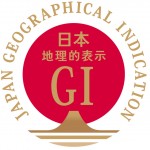
The Geographical Indication (GI) Protection System is a system to protect names of products with properties such as quality and social reputation, and so on that have been nurtured by natural, human, and social factors and environments unique to the region as regional intellectual property. The system has already been introduced in more than 100 countries around the world, and was introduced in Japan in 2015.
What is GI?
Taking the Ichida persimmon (One of the famous varieties in Japan) as an example, the relationship between “product (place of production and properties)” and labeling is as follows.
| Product | GI | |
|---|---|---|
| Place of production | Properties | |
-Only “Ichida persimmon” originated in Takamori-cho, Shimoina-gun (former Ichida-mura) is used. |
-“Ichida persimmon” has especially high sugar content. |
Ichida Persimmon |
GI is a registration given to a producer organization for a product and used by its members. The registration details are described in the specification and producer organizations provide their members with the guidance to comply with the production method. One of the features of the system is that the administration will crack down on any illicit use of the GI labeling.
For any illicit labeling found, such as “TROPICAL KOBE BEEF” for the beef from South America on the restaurant’s menu in Spain, “Wagyu ‘Kobe-Style'” labeling for wagyu beef from New Zealand in a supermarket in Germany and so on, EU authorities will be requested to take appropriate measures against such labeling that will be removed by the guidance by the authorities under the framework of mutual protection system with European countries.
The Japanese GI system has focused on ensuring superior quality control to other products, stricter control over the manufacturing process than other products and the strengthening of product brands through the exclusion of imitation products. However, as a result of the gradual tightening of such control operations, GI labeling has been disproportionately implemented on the products mainly from local farms or traditional vegetables with smaller crops and so on, that are organized by region because they are easily differentiated in their quality over other standard products.
Outline on review of the operation
The operation of the GI system has been under review since November 1, 2022. The aim is to further encourage export of products by widening the scope of registration to include not only traditional regional vegetables but also processed products and products for overseas.
The outline of the revision is as follows.
| 1. Review of evaluation criteria | -Even without differentiated quality, promoting judgement based on the evaluation of the unique and varied properties of the product, such as quality, production method, reputation, and story, which have been nurtured in the natural, human, and social factors and environment of the region |
|---|---|
| 2. Review of procedures before and after the registration | -As for genuine GI products which do not harm the interests of consumers who purchase the products, enable continuous use of registered names even with a new name added which divides the original form of registered names (e.g. “Kasumigaseki XX Apple” for the registered name, “Kasumigaseki Apple”) so that such unification with the new name would never hamper the consensus formation on the application |
| 3. Expand exposure in the GI market | -Clarify the rules for using the GI mark on GI processed products |
In the GI system in Europe, where processed products account for the majority and many products are also exported, products are valued not for their superiority to other products, but for their unique attractiveness and strengths linked to the region. The review for the Japanese system is aimed at expanding the use of this system by pursuing more simplified procedures, while reviewing the evaluation criteria with reference to such overseas systems.
The labeling and the future of GI products
This operational review will not have a significant impact on food labeling practices themselves. The same points to note regarding Japanese registered GI (122 products**) and foreign GI* (112 products**) protected in Japan remain unchanged.
(* Refer to “Geographical Indication” →”Information on designated GIs” (MAFF’s website) e.g.: Grana Padano (natural cheese)) ** as of Dec.9,2022Taking a look at the revision of the GI system will be useful especially for those who export food products from Japan to overseas. EU is also considering a revision of the GI labeling system to include “sustainability” as a requirement for GI labeling. It would be good to confirm this together with these current trends.
References
- Review of operation of Geographical Indication Protection System (MAFF)
- Information on designated GIs(English ver.) (MAFF)
- List of Designated Products (Japanese ver.) (“Protection for imported food products with GI in Japan”)(MAFF)
- Commission strengthens geographical indications to preserve high quality and reinforce protection(EU)
Share/Like/Follow:
Newsletter Signup
We issue monthly e-newsletters, which provide you with the latest updates on food labeling/regulations in Japan.
If you want to make sure to not miss any issue, please click below.
Related Service
Research Services on Ingredients & Food Labeling -For the Japanese Market-
We verify the conformity of ingredients and additives with the standards for use in Japan based on specifications such as formulation lists. We also verify the conformity of the proposed labeling of ingredient names, nutrients, etc. with the labeling standards based on specifications such as formulation lists.

Label bank Co., Ltd. CEO (Founder)
Born in Japan. Working on solving various issues related to food labeling operations. Also regularly gives lectures for various organizations in Japan.
Co-author of ‘Latest edition: Guide book Food Labeling Law and related business practical points – from scratch (Japanese version only)’ (DAI-ICHI HOKI CO., LTD/2019).


